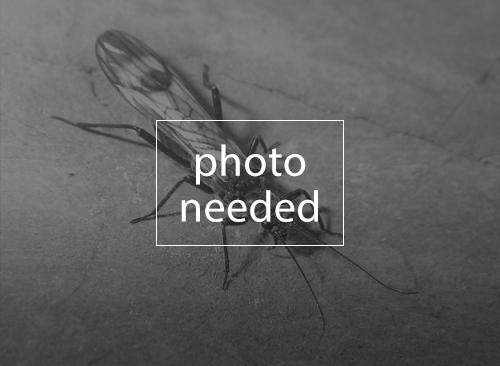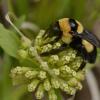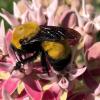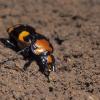
(Odonata: Zygoptera: Coenagrionidae)
Megalagrion nigrohamatum nigrolineatum is endemic to the Hawaiian island of Oahu. This subspecies was found historically in the mountain ranges of Koolau and Waianae, and is currently known from 16 stream sites at high altitudes in the Koolau Range. Its limited habitat and small scattered populations may affect long-term stability. The species is susceptible to the effects of habitat loss and introduced species. Research should focus on habitat management and protection, and control of invasive species.
Megalagrion n. nigrolineatum is in the family Coenagrionidae (pond damsels). Adults are medium-sized, from 35-45 mm (1.4-1.8 in.) in length with a wingspan of 43-50 mm (1.7-2.0 in.). Adults of both sexes can be recognized by the lime green to blue-green coloration on the lower half of the face and eyes (Polhemus & Asquith 1996), and the top portion of the eyes is bright red. Males have a dark abdomen with an organge-red tip, and a broad yellow, red, or orange patch on the side of the thorax. Females have a similar pattern but the patch on the thorax may be yellow to light blue, and final segment of the abdomen is dull orange.
Nymphs reach up to 20 mm (0.8 in.) in length. The flattened, leaf-like gills at the tip of the abdomen have slender pointed tips and prominent branching veins.
Megalagrion nigrohamatum nigrolineatum Perkins 1899. Although sometimes listed as M. nigrolineatum, it has not formally been elevated to full species rank. J. Daigle feels strongly that M. lineatum is a distinct species, based on coloration, morphological differences, and differences in distribution from M. nigrohamatum (Daigle 2000, Daigle pers. comm. 2008).
The predaceous aquatic nymphs inhabit standing pools in the headwater and midreach sections of upland streams, and the seeps that border these streams, often hiding beneath rocks or algal mats. Adults are weak fliers and prefer to perch on streamside rocks or vegetation (Polhemus & Asquith 1996).
This species was reported historically as being widespread on Oahu, from sea level to 732 m in the windward and leeward drainages of the Koolau and Waianae mountain ranges. Currently M. n. nigrolineatum is present in sixteen widely dispersed streams on both the windward and leeward sides of the Koolau mountains. Some of these remaining populations may be considered robust (Federal Register 2007).
This damselfly is associated with standing pools in the headwater and midreach sections of upland streams, and the seeps that border these streams.
Canada – Species at Risk Act: N/A
Canada – provincial status: N/A
Mexico: N/A
USA – Endangered Species Act: Candidate
USA – state status: S2 Imperiled
NatureServe: G4T2 Apparently secure; Subspecies imperiled
IUCN Red List: VU Vulnerable
The blackline damselfly is currently a candidate for listing under the Endangered Species Act. This species was commonly collected as late as the 1970s, after which time collections declined sharply. It is currently restricted to sixteen sites, primarily in regions of habitat without nonnative fish. Existing state regulatory mechanisms do not provide sufficient protection, although the larger number of scattered populations of this damselfly compared to other candidate Megalagrion species may provide some protection against imminent extinction.
M. n. nigrolineatum is threatened by habitat loss and the effects of introduced species, including predaceous fish and backswimmers (Hemiptera: Notonectidae). Hawaiian damselflies evolved in the presence of few predatory fish, and immatures may exhibit exposed swimming and feeding behaviors that make them vulnerable to predation by poeciliid fish introduced for mosquito control. Resource and habitat competition from introduced species of caddisfly (Trichoptera) may also have a negative impact on this subspecies (Flint et al. 2003). The habitat may also be impacted by invasive plants such as California grass (Brachiaria mutica), which forms dense stands that can eliminate open water (U.S. Fish & Wildlife Service 2007).
Conservation needs include monitoring known populations, habitat protection, and removal of invasive species.
A formal taxonomic description is needed for this subspecies to be elevated to full species status. Research into habitat management would be valuable. Interactions and potential resource competition between the endemic M. nigrohamatum nigrolineatum and introduced invertebrate species are poorly understood.
Daigle, J. 2000. The distribution of the Odonata of Hawaii. Bulletin of American Entomology 6(1):1-5.
Federal Register Environmental Documents. 2007. Endangered and Threatened Wildlife and Plants; Review of Native Species That Are Candidates for Listing as Endangered or Threatened; Annual Notice of Findings on Resubmitted Petitions; Annual Description of Progress on Listing Actions. Vol. 72:234.
Flint, O. S., Englund, R. A. and Kumashiro, B. R. 2003. A reassessment and new State records of Trichoptera occurring in Hawaii with discussion on origins and potential ecological impacts. Bishop Museum Occasional Papers 73:31-40.
Hawaiian Terrestrial Arthropoda Checklist. 2nd Edition. 1994. Nishida, G.M. (ed.) Hawaii Biological Survey, Contribution No. 94-04. Bishop Museum. Honolulu, Hawaii. 287 pp.
Perkins R. C. L. 1899. Fauna Hawaiiensis, Sharp D. (ed.).
Polhemus, D.A. and Asquith, A. 1996. Hawaiian Damselflies. A field identification guide. Bishop Museum Press, Honolulu.
U.S. Fish and Wildlife Service. 2007. Species assessment form for the blackline Hawaiian damselfly. Available online.
Additional Resources
Profile prepared by Celeste Mazzacano, The Xerces Society for Invertebrate Conservation





